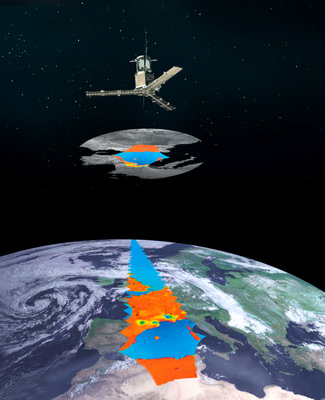The European Space Agency’s Soil Moisture and Ocean Salinity (SMOS) satellite has been cleared for takeoff, following nearly a year in limbo while the mission team awaited the go-ahead from a private launch company.
Originally expected to launch in 2008, SMOS has been in storage at Thales Alenia Space’s facilities in Cannes, France since last May, awaiting a launch appointment at the Russian Plesetsk Cosmodrome, north of Moscow. If all goes according to plan, the craft will now launch between July and October, the second ESA mission in a series of six designed to observe Earth from space and bolster an understanding of climate change. The first of the satellites in its new Living Planet Program, The Gravity field and steady-state Ocean Circulation Explorer (GOCE), is scheduled to go up March 16.
Over its lifetime of about 20 months, GOCE will map global variations in the gravity field – crucial for deriving accurate measurements of ocean circulation and sea-level change, both of which are affected by climate change.
SMOS, circulating at a low orbit of around 750 km (466 miles) above the Earth, will be the first mission dedicated to mapping soil moisture and ocean salinity. Salinity in the oceans has a significant impact on ocean circulation, which in turn helps drive the global climate. Among other applications, understanding the salinity and temperature of the seas will lead to easier predictions of the zones where hurricanes intensify. A specialized radiometer has been developed for the mission that is capable of observing both soil moisture and ocean salinity by capturing images of emitted microwave radiation around the frequency of 1.4 GHz (L-band). SMOS will carry the first-ever, polar-orbiting, space-borne, 2-D interferometric radiometer. The mission is designed to last three years.
Here’s a rundown of the final four planned crafts in the series:
- ADM-Aeolus (Atmospheric Dynamics Mission), with a 2010 launch date, will collect data about the global wind profile to improve weather forecasting.
- CryoSat-2, set to launch in late 2009, will determine variations in the thickness of the Earth’s continental ice sheets and marine ice cover to further our understanding of the relationship between ice and global warming. CryoSat-2 replaces CryoSat, which was lost at launch in 2005.
- Swarm, due for launch in 2010, is a constellation of three satellites to study the dynamics of the magnetic field to gain new insights into the Earth system by studying Earth’s interior and its environment.
- EarthCARE (Earth Clouds Aerosols and Radiation Explorer), lanching in 2013, is a joint European-Japanese mission that aims to improve the representation and understanding of the Earth’s radiative balance in climate and numerical weather forecast models.


Im not much of a global warming person but these are excellent.
The more observational data in any field of science is always a good thing.
I’m glad the ESO satillite will study the very complex oceanic circulation not now fully understood- I hope this will begin to have some answers why tropical storms activities
changes-when the Atlantic Ocean has many tropical storms, the tropical storms in the Western North Pacific drops as does the Eastern Pacific off the central American waters. 2005 is one example, there was many super Hurricanes in the Atlantic, while there was near record low occurance in the Western North Pacific and Eastern Pacific and why these cycles occurs. This ESO satillite will be quite an advance to truly study our complex Earth
I can tell you about Climate Change.
It is called Winter, Spring, Summer and Fall.
Soil moisture is now WET in the upper midwest. No oceanic levels are rising because the Communist News Network (CNN) would be all over that one.
I’m glad some people have money to spend, but this particular satellite doesn’t interest me at all.
Soil Moisture and Ocean Salinity? From an orbit around the earth? If I had read in a science fiction novel, I would have laughed. I never dreamed that such a thing would be possible.
It is up there with measure a single photon or isolating a single electron. We live in amazing times.
Ironically, the energy use of a small city will go into creating and placing this satellite into orbit : )
If you want to stop a whole lot of greenhouse gases from being produced, you should slaughter the great herds of the Serengeti.
I have been a skeptic on the whole global warming issue, until I read, “Agenda for a Sustainable America,” written by John Dernbach
and 40 additional climate change experts. The book makes clear, sustainability is not just the new buzz word for environmentalism. Sustainability, rather, is about how the environment is linked to everything else we care about. I am interested to hear more about the results of this satellite.
Sorry Anne…
“The European Space Agency’s Soil Moisture and Ocean Salinity (SMOS) satellite has been cleared for takeoff next month”
“If all goes according to plan, the craft will now launch between July and October”
When?
It’s pretty cool to see science being done like it should.
http://freeipodtouch4real.com
Thanks Eduardo!
If the findings of the SMOS shows salinity of the N. Atlantic changes:
http://en.wikipedia.org/wiki/Thermohaline_circulation
http://en.wikipedia.org/wiki/Shutdown_of_thermohaline_circulation
such talk of Global Warming will be mute, however, the- norwegian,sweds others will have to migrate south-I doubt these people will take to the roads with large armies using motorcycles and the troops has huge beer bellies wearing Viking helmets with the horns and terrorizing peoples to the south, but there must be migrations and probably causing wars, famine, diseases.
I’ve said on previous feeds, the opposite effect can happen